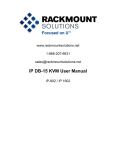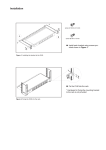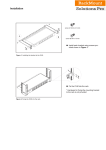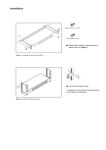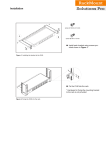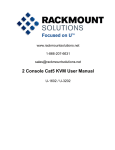Download Rackmount UIP-3202 User manual
Transcript
UIP-1602 / UIP-3202 IP Cat5 KVM Installation screw A: M3.2 x 4.5 mm A B iew rV be Cy screw B: M4 x 10 mm ■ Install each bracket using screws provided shown in Figure 1. ■ Fix the KVM into the rack Figure 1. Installing the bracket to the KVM. iew rV be Cy Figure 2. Fixing the KVM into the rack. * Hardware for fixing the mounting bracket to the rack is not provided UIP-1602 / UIP-3202 IP Cat5 KVM Package Content (only for rackmount KVM) 1 5 al User Manu 2 3 4 6 7 1 KVM switch x 1 pc 2 Screw M3.2 x 4.5mm x 4 pcs 3 Screw M4 x 10mm x 8 pcs 4 Bracket x 1 set 5 User manual x 2 sets (KVM x 1 set ; IP KVM + CD disc x 1 set) 6 Power cord x 1 pc 7 CD disc x 1 pc (for IP KVM setup) UIP-1602 / UIP-3202 IP Cat5 KVM Connection UIP-1602 Dual power Local with failover Console USB Serial Ethernet Cascade UIP-3202 Connection Rackmount KVM Internet hub Cat5 cable (up to 132 ft) Cat5 cable DG-100S dongle Connection KVM modules Internet hub back Cat5 cable Cat5 cable (up to 132 ft) DG-100S dongle ■ For USB & serial connection, please refer to the attached IP KVM user manual UIP-1602 / UIP-3202 IP Cat5 KVM Cascade ■ Cascaded KVM ( Bank 2 to 8 ) must be single console Cat5 KVM - U-1601 / U-3201 ■ With the UIP-1602 cascade up to 128 servers. With the UIP-3202 cascade up to 256 servers. ■ Cascading multiple KVM by CBC-6 cable Cascade Rackmount KVM UIP-3202 IP Cat5 KVM Local Console Bank 1 Cascade CBC-6 cascade cable U-3201 Cat5 single console KVM Bank 2 Bank 8 Cascade KVM modules back UIP-3202 IP Cat5 KVM Local Console Bank 1 Cascade CBC-6 cascade cable U-3201 Cat5 single console KVM Bank 2 Bank 8 DG-100 / DG-100S Dongle Connection DG-100 PS/2 dongle ■ To connect DB-15 connector to the computer’s video card ■ To connect keyboard connector to the computer’s keyboard port ■ To connect mouse connector to the computer’s mouse port mouse Cat5 KVM switch Keyboard DB-15 Cat5 cable (up to 132 ft) DG-100 PS/2 dongle PS/2 server DG-100S USB dongle ■ To connect DB-15 connector to the computer’s video card ■ To connect USB connector to the computer’s USB port Cat5 KVM switch USB DB-15 Cat5 cable (up to 132 ft) DG-100S USB dongle USB server KVM Membranes Power ON ■ Turn off all servers and KVM switches ■ Make sure all cables / connectors are properly connected ■ Recommend Power ON sequence is monitor, KVM switch finally computer Front Panel - Port LED Indications 16 ports Bank no. PC port LEDs Channel button Bank button 32 ports Bank no. 7-Segment BANK LED indication PC port LEDs Power : Orange LED on indicating a PC is connecting to the port Access : Red LED on indicating a selected channel Channel button Press to select channel from 01 to 32 Bank button Select the bank from 1 to 8 Password The password is disabled by default ( i.e. There is no password required when you power on the KVM switch for the first time) ■ Enable password 1. Press the KVM hotkey Scroll Lock + Scroll Lock + U 2. Logout the KVM by pressing the hotkey Scroll Lock + Scroll Lock + P 3. In SUPERVISOR level, enter “00000000” eight zeros in user name & password field (Do not use “0” on number pad) 4. In USER level, press Space bar + Enter in user name & password field Remark: Automatic logout after 10 minutes of inactivity ■ Set your own user name & password 1. Login the KVM in SUPERVISOR level by pressing “00000000” eight zeros in user name & password field 2. Call KVM OSD menu by pressing the KVM hotkey Scroll Lock + Scroll Lock + Space Bar 3. Press F1 to the MAIN MENU 4. Select “USER SECURITY” 5. Set password in SUPERVISOR & USER level a. In the left-top row “S” (SUPERVISOR), press Enter to set your own user name & password b. In the row 1 to 8 (USER), press Enter to set your own user name & password 6. Press Enter to save the setting or press Esc to cancel the editing without any change Remark: a. Blank has underscore, while SPACE doesn’t have b. Press any alphanumeric key to move to next input item. SPACE is treated as a valid character ■ Change your password 1. Login the KVM in SUPERVISOR level by pressing your own user name & password 2. Call KVM OSD menu by pressing the KVM hotkey Scroll Lock + Scroll Lock + Space Bar 3. Press F1 to the MAIN MENU 4. Select “USER SECURITY” 5. Change password in SUPERVISOR & USER level a. In the left-top row “S” (SUPERVISOR), press Enter to change your user name & password b. In the row 1 to 8 (USER), press Enter to change your user name & password 6. Press Enter to save the setting or press Esc to cancel the editing without any change Remark: a. Blank has underscore, while SPACE doesn’t have b. Press any alphanumeric key to move to next input item. SPACE is treated as a valid character ■ ■ Disable your password 1. Press the KVM hotkey Scroll Lock + Scroll Lock + U 2. Logout the KVM by pressing the KVM hotkey Scroll Lock + Scroll 3. You don’t need user name & password to access the KVM OSD menu Forget your password Please contact your supplier for further support Remark: ■ You must press the KVM hotkey within 2 seconds ■ A beep sound will be heard for successful entering KVM hotkey Lock + P KVM OSD OSD Menu OSD operation next to the system name The PC is powered on next to the system name The PC is selected F1 Access F1 MAIN MENU F2 Logout the OSD menu F3 Previous menu Esc Cancel / Quit Enter Complete / Switch to selected port Switch to previous or next port PgUp/PgDn Switch to previous bank or next bank 1/2/3/4 Display port 01 ~ 08 / 09 ~ 16 / 17 ~ 24 / 25 ~ 32 Remark: Display port 17 ~ 32 for 32 port model only F1 Main Menu 01 LANGUAGE OSD language change 02 PORT NAME EDIT Define port name 03 PORT SEARCH Quick searching by port name 04 USER SECURITY Change password 05 ACCESS LIST Define user access authority 06 HOTKEY Change hotkey 07 TIME SETTINGS Modify scan display time interval 08 OSD MOUSE Modify OSD mouse speed KVM Hotkey Local Console Hotkey Hotkey Function Scroll Lock + Scroll Lock + Space Bar Calling OSD menu Right-button mouse + Esc Calling OSD menu Scroll Lock + Scroll Lock + Switch to previous port Scroll Lock + Scroll Lock + Switch to next port Scroll Lock + Scroll Lock + PgUp / PgDn Switch to previous bank or next bank Scroll Lock + Scroll Lock + Bank no. + Port no. Switch to specific port Scroll Lock + Scroll Lock + B Turn the buzzer ON and OFF * Default the buzzer is ON Scroll Lock + Scroll Lock + P Logout the KVM if password security is ON. Show up the status windows Advance hotkeys (for Supervisor login only) Scroll Lock + Scroll Lock + S Activate auto-scan mode for connected servers *Press any key to exit the auto-scan mode Scroll Lock + Scroll Lock + R Reset all the KVM settings to factory default *Except User Security settings Scroll Lock + Scroll Lock + U Disable and enable password security *Default security is OFF Scroll Lock + Scroll Lock + L To enable / disable the screen saving function and 10 mintues auto-logout *Default the screen saving is OFF Remarks: ■ Example of “Scroll Lock + Scroll Lock + Bank no. + Port no.” - Bank No. : 1 to 8 - Port No. : 01 to 16 - e.g. Bank 1 Port 4 : Scroll Lock + Scroll Lock + 1 + 0 + 4 - e.g. Bank 2 Port 16 : Scroll Lock + Scroll Lock + 2 + 1 + 6 ■ You must press the hotkey within 2 seconds ■ A beep sound will be heard for successful entering ■ The numeric keypad is not supported, while in OSD screen, the arrow keys, PgUp, PgDn, and Enter keys are supports Remote Console Hotkey Hotkey Function Caps Lock + Caps Lock + F1 Show up the Help OSD windows Caps Lock + Caps Lock + F2 Select Hotkey *Default is Caps Lock Caps Lock + Caps Lock + C Toggle switch between remote & local port Caps Lock + Caps Lock + Q Turn the buzzer ON & OFF *Default the buzzer is ON Caps Lock + Caps Lock + S Activate auto-scan mode for remote & local port *The scan time interval is 5 seconds Caps Lock + Caps Lock + A Auto-adjust the video signal UIP-1602 / UIP-3202 IP Remote Setup Quick Installation Guide of IP KVM for remote access Please perform the follow steps 1. Power off all KVM hardware and connected devices. 2. Connect the power supply to IP KVM 3. Connect the monitor, keyboard & mouse to console port of IP KVM (not applicable to integrated LCD drawer version ) 4. Connect the KVM cable to IP KVM and target servers 5. Use an Ethernet cable to connect your local area network (LAN) to the IP console port on the KVM Initial IP configuration The factory default, DHCP mode is disable (IP auto configuration = None), and the preset default address as below : IP address : 192.168.1.22 (default) Subnet-mask : 255.255.255.0 Default Gateway: None Install the “PSetup.exe” program from the provided CD-disc to a computer which networked with IP KVM switch, then press Refresh Devices the look for the IP-KVM. a. Select the MAC address from label on the bottom of the IP-KVM switch b. Click Query Device a b 1. Configure the IP KVM with fixed address a. Setup “IP auto configuration” as “None”; setup IP address and Subnet mask b. Enter Super user login and password for Authentication (default : super/pass) c. Setup Device. If super login was authenticated, it’ll show “Successfully configured device”. Otherwise it’ll show “Permission Denied”. 2. Configure the IP KVM with DHCP a. Setup “IP auto configuration” as “DHCP” b. Enter Super user login and password for Authentication (default : super/pass) c. Setup Device. If super login was authenticated, it’ll show “Successfully configured device”. Otherwise it’ll show “Permission Denied”. 3. Install JVM on Client system The IP-KVM switch was remote accessed by a standard JAVA enabled web browser. The client system must install Sun JVM 1.4.2 or above for remote access the IP KVM. Remark: ■ At a minimum, you must have Internet Explorer 6.0 or Netscape 7.0 or Molliza 1.6 (and above) installed on your client computer. UIP-1602 / UIP-3202 IP Remote Setup 4. Remote access the IP-KVM switch via Web Using the HTTP protocol or a secure encrypted connection via HTTPS and entering the configured IP address of IP KVM switch into the web browser to remote access the IP KVM switch. With successful connection to IP KVM, the login page will show as below, then key in the default user name & password 5. After successful login to IP KVM, you will enter the main page of IP KVM as below : Remark: ■ We strongly recommend the user changes the default username and password to user specific values ■ Please refer to the “IP KVM User Manual” for more detailed information about IP KVM switch. Optional Accessories 1. Cat5 cable 1.1 CU-3 3 feet 1.2 CU-6 6 feet 1.3 CU-10 10 feet 1.4 CU-15 15 feet 1.5 CU-33 33 feet 1.6 CU-66 66 feet 2. Cat5 / USB KVM cascade cable 2.1 CBC-6 6 feet 3. PS/2 Dongle for Cat5 KVM 3.1 DG-100 PS/2 4. USB Dongle for Cat5 KVM 4.1 DG-100S USB 5. Power cord 5.1 IEC power cord 5.2 NEMA 5-15 power cord (US) 5.3 BS 1363 power cord (UK) 5.4 CEE 7/4 power cord (German) 5.5 AS 3112 power cord (Australia) DC Power 12V, 24V, 48V Input Model 12V 24V 48V Input voltage: 12-Volt 24-Volt 48-Volt Input range: 9 ~ 18V 18 ~ 36V 36 ~ 75V - No load 50 mA 50 mA 50 mA - Full load 4950 mA 2450 mA 1220 mA Output voltage: 12-Volt 12-Volt 12-Volt Output current: 4.16A 4.16A 4.16A Ef?ciency 84% 85% 85% Input rating Input current Output rating Remarks: ■ Package does not include power cord Specification UIP-1602 / UIP-3202 ▀ ▀ ▀ KVM Port Number of ports: 16 or 32 Connector: RJ-45 Connectivity: DG-100S USB dongle / DG-100 PS/2 dongle up to 132 feet Local Console Graphic connector: HDDB15-pin Resolution: Up to 1600 x 1200 Input device: 2 x USB type A for keyboard & mouse IP Remote Console Connector: RJ45 Ethernet User management: 15-user login, 1 x active user Network protocol: DHCP / BOOTP / DNS Security: SSL v3, RSA, AES, HTTP / HTTPs, CSR Resolution: Up to 1600 x 1200 Browser: IE, Firefox, Safari, Netscape Others: Serial port, virtual media via USB ▀ Expansion: Up to 256 servers by 8-level cascade ▀ Compatibility ▀ Cat5 Multi-platform: Mix PCs, SUNs, IBMs, HPs, DELLs Server Support: Windows Vista / 2003 / XP / 2000, Linux, Netware, Unix Power Input: 100 or 240V AC at 50 or 60 Hz via IEC type cord OR AC / DC power adapter [email protected] (optional) Option DC: 12V / 24V / 48V DC input Consumption: Max. 25 Watt ▀ Regulatory Approval: FCC, CE ▀ Environmental ▀ ▀ Operating: 0 to 50°C Storage: -5 to 60°C Relative humidity: 90%, non-condensing Shock: 50G peak acceleration (11ms, half-sine wave) Vibration: 58~100Hz / 0.98G (11ms / cycle) Product Information Dimension (W x D x H): 443 x 180 x 44 mm / 17.3 x 7.1 x 1.73 inch Net weight: 4 kg / 9 lb Packing Information Dimension (W x D x H): 510 x 400 x 77 mm / 20.1 x 15.7 x 3 inch Gross weight: 7 kg / 15 lb FAQ General 1. How do the KVM switches allow the user to switch ports? There are two ways to switch ports. One is the membrane buttons on the front and the other way is with Hot-key commands. 2. What operating systems do the KVMs support? The KVMs support multi-platform support allows you to control Windows-based computers, Sun Solaris systems, Linux, or even Macs by a single KVM switch. The KVM switches support multi-platform operating systems including but not limited to DOS, Windows 95/98/ME/NT/2000/XP, Linux, Solaris and Mac OS. 3. Do I have to power down the KVMs to add a new server ? The KVMs are hot-pluggable and allows servers or devices to be added or removed without powering down the switch, but components of connected devices, such as the servers, may not be hotpluggable. We suggest that turn off power to all devices before connecting them. 4. Why I can’t login with default password on KVM switch The default username and password for the KVM switch is eight zeros - “00000000”. Please check i. The “Num lock” is not turned on. (for notebook type keyboard) ii. The numeric (number) keys on the number pad are not accepted by KVM, only the main number keys. 5. Can I disable the KVM password ? Yes, for Cat5 KVM, USB KVM, two console PS/2 KVM & IP PS/2 KVM, user can disable/ enable the KVM password by hotkey. No, for PS/2 KVM, user can’t disable the KVM password. 6. What do I do if I forget the password? If the user change the default password and lose the password, pls contact the supplier for further support. 7. How many levels of KVM cascade are supported? 8 levels are supported. 8. Can I cascade the different types KVM switches together ? No, only same type KVM can cascade together. (e.g. PS/2 to PS/2, USB to USB,..) 9. Why am I getting ghosting images or shadowing? i. Check that all video cables are inserted properly. ii. Check whether the KVM supports the resolution and refresh-rate on your servers. iii. Check whether the graphics card you are using supports the resolution and refreshrate on your server or not. iv. Connect the monitor directly into the servers you are having trouble with to see if problem still appears. FAQ 10. The server VGA resolution does not match the resolution of monitor ? The KVM supports DDC function which will dynamically detect and the DDC data. The problem may come from the power on sequence. For KVM switch The recommended power on sequence is - monitor, KVM switch and then servers. For remote console box It supports DDC function but does not support hot-plug, the recommend power on se quence is – monitor, remote console box and then servers. Cat5 KVM Can I use standard Cat5 cable for Cat5 dongle ? The Cat5 dongle can support Cat5/5e straight cable. To maximum performance and stability, we strongly recommend applying the Cat5e cable (CU-3 / 6 / 10 / 15 / 33 / 66) from us, we are designed and qualification tested using pre-made (factory made) Cat5e cable assemblies in fixed lengths. Using this type of cable assembly will provide excellent link connections and data communication. As poorly made field cable assemblies can cause damage to the Cat5 KVMs & dongles and result in a poor or intermittent link. The warranties do not apply to damage resulting from user-supplied cable. Troubleshooting 1. There is no LED display on KVM membrane switch i. Make sure the power adapter plugged into the KVM Switch, if the LED’s still off, perform soft reset to KVM switch. ii. Power cycle KVM switch. 2. I can power on the KVM, but I am not getting any picture at all, how can I solve this? Switching to another port and checking if this port has the same problem a. If you switch to another port, please check the screen resolution is the same. b. Check the OSD menu is available on the hot keys “Scroll lock + Scroll lock + space bar”. If the problems persist, please make sure the cables are inserted properly and the boot up sequence is followed. 3. The screen is on but the keyboard and mouse don’t work i. Check the server by using a different keyboard and mouse. ii. For PS/2 servers The keyboard and mouse are not hot pluggable. iii. For USB servers Unplug and plug allowing a few seconds for the bus emulation process to complete. iv Do not press any keys on the keyboard whilst the server is booting up. This can cause a keyboard error or cause the keyboard not to detect the KVM switch. v. Try a different keyboard, but use only 101/102/104-key keyboard vi. Avoid moving the mouse whilst switching the KVM ports. 4. There is no LED display on the Cat5 dongle The LED on the Cat5 dongle will flash when plugged into the USB or USB server. The light will then become steady when the KVM switch has connected. If the LED light is on and not flashing when plugged into server, please unplug the USB or PS/2 and try again. Or try another good Cat5 dongle to verify if problem still appears. If the problem persists, please contact your supplier.

















